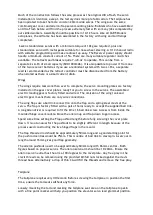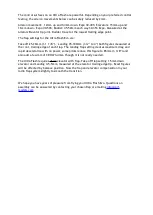
Keep the lead spacing as wide as possible to reduce the chance of the lead coming into
contact with the tailpipe.
Servos with a maximum width of 21mm can now be fitted. A servo arm length between 19
and 20mm produces the maximum movement required. Open the servo arm slots to fully
clear the servo arms once you have positioned the servos on the brackets.
A small amount of thread lock on the M3 screws fixing the servos is recommended.
Visible threaded rod between the clevis and ball joint on the elevator pushrods will be
approximately 27mm. Ensure the servo arm is at 90 degrees to the cover plate at the
neutral position before setting the final pushrod length.
Fuselage
The correct balance is easily achieved on the UF Evo without ballast. Start assembling the
fuselage from the back and the final battery positions will find themselves.
Before starting construction, light sanding of the factory installed wood work is
recommended. We also coat the wood parts with a thinned epoxy skinning resin like
ZAP40. This seals the wood and prevents oil and moisture being absorbed over the life of
the model.
The tailpipe opening in the fear fuselage face and mating tailcone opening may require
elongating to allow the tailpipe to align correctly.
The rudder servo must be mounted before the tailpipe can be finally installed. The factory
installed plywood servo mount should have any excess resin filed away and the four
mounting holes cleared before trying to mount the servo.
The servo is mounted with the top of the servo lugs against the mounting plate-so install
the grommets and ferrules based on this. A servo arm between 20 and 25mm should be
used. A slot is required in the fin skin to clear the rudder servo arm.
Note which side the rudder horns are before making the slot!
A simple method of finding the centre of the servo horn is to install a slightly sharpened
nylon arm of 15-16mm length on your chosen servo. Turn the unpowered servo arm so it is
in line with the servo case and screw the servo in position to compress the grommets.
Power the servo with a tester or your radios throttle channel and slowly move the servo
arm so it scratches through the foam inner skin. A torch can help find this line. Add
masking tape to protect the paint work and mark the slot before cutting.
After finally mounting the rudder servo a strip of composite/balsa laminated 3mm sheet
approximately 50mm wide should be glued across the fuselage to act as a direct heat
shield to the servo case bottom.
Tailpipe
Before assembling the tailpipe by screwing the carbon bell mouth to the steel inner pipe,
the moulding may require some cleaning up. Use a course file or sandpaper (always wear a






















